Get Expert Financing
- Matched with investor-friendly lenders
- Fast pre-approvals-no W2s required
- Financing options fro rentals, BRRRR, STRs
- Scale your portfolio with confidence
You may have heard people talk about refinancing their mortgage, but do you know when and why refinancing makes sense? Here are some common reasons to refinance your mortgage.
– Lower interest rate: Interest rates have been low for a while, but even if you’ve only had your mortgage for a few years, you might find that interest rates have dropped since you first took out your mortgage. A lower interest rate means less interest paid on the money you’ve borrowed, so that often means tens of thousands of dollars saved.
– Lower monthly payment: Refinancing a mortgage can often result in a lower monthly payment. This can be due to a lower interest rate and/or the extension of the term of the mortgage. For example, suppose you have an original mortgage of $200,000 for 30 years at 4.5% interest and now the balance is $160,000 with 20 years left. If you refinanced the balance for another 20 years at 4% interest, your monthly payment would drop by about $40. If you refinanced the balance for 30 years at 4.5% interest, your monthly payment would drop by about $200, although you’ll end up paying more in interest because you’re borrowing money for an additional ten years. If you refinance the balance for 30 years at 4% interest, your monthly payment would drop by nearly $250. You would still pay more in overall interest than the original mortgage because you’d be borrowing money for another ten years.
Submit Your Loan Scenario– Cash out equity: Sometimes people refinance to access the equity in their home. Ideally, if you’ve been making your monthly payments and you’ve been in your home for a while, the house has increased in value and you’ve paid off some of the principal of the mortgage, so you own more of the property than what you put down at the time of purchase. For instance, suppose you bought a house at $250,000 and put down 20 percent, or $50,000, and took out a $200,000 mortgage. Also assume that you’ve made all of the monthly payments so that after ten years, the balance on your mortgage is $160,000. Further assume that the property is now worth $300,000. You would then have $140,000 of equity in the house – $50,000 from the original down payment, $40,000 from the principal you’ve paid off, and $50,000 due to the increase in property value. You could choose to refinance your mortgage for an amount higher than the $160,000 you currently owe, and receive the difference in cash from the lender. For example, you could refinance with a $200,000 mortgage and get back $40,000 at the time of closing from the lender. You will, of course, end up paying more in interest overall, but if you need to borrow money – perhaps to pay for a remodel – a cash-out refinance may be a cost-effective option.
– Shorten the mortgage term: As mentioned above, a refinance can extend the time you have a mortgage, but it can also shorten that time. Shorter-term mortgages mean lower interest rates, so you may find that you can save money by refinancing to a shorter-term mortgage.
– Switch from an adjustable rate mortgage to a fixed rate mortgage: An adjustable rate mortgage usually comes with a low interest rate for the first few years, but after that initial period expires, the rate can go up each year. Experts often recommend refinancing before that initial period expires, so you can lock in a fixed rate rather than risk higher monthly payments due to higher interest rates on an annual basis.
– Eliminate PMI: Another reason to refinance your mortgage is to eliminate Private Mortgage Insurance. PMI can be eliminated once the value of the equity in your house is greater than 20 percent. If the value of your property increases, and/or you pay extra toward the principal of your mortgage, you may hit 20 percent equity before the lender’s original amortization schedule. Unfortunately, some lenders can be difficult about dropping PMI ahead of the original schedule. In such situations, refinancing – which would include an appraisal showing that your equity is now greater than 20 percent – may be the quickest and easiest solution for eliminating PMI.
– Remove someone from the mortgage: A refinance may be the only way to remove one party from the mortgage. For example, if a couple divorces and one spouse becomes responsible for the mortgage, a refinance will remove the other spouse from the new mortgage.
Note that you should plan to stay in your home long enough to recoup the closing costs. Refinancing a mortgage usually isn’t free. You should plan to pay several thousand dollars for various fees like an application fee, appraisal, title search, title insurance, document preparation, and points for a lower interest rate. To determine your break-even point, divide the total closing costs by the amount of monthly savings. For example, if closing costs are $4,000 and your monthly mortgage payment will be $200 less, then it will take 20 months to recoup the closing costs ($4,000 ÷ $200 = 20 months). To realize savings from the refinance process, you’ll need to stay in your home for over 20 months. If you plan to move before then, it may be best not to refinance.
Our advice is based on experience in the mortgage industry and we are dedicated to helping you achieve your goal of owning a home. We may receive compensation from partner banks when you view mortgage rates listed on our website.


